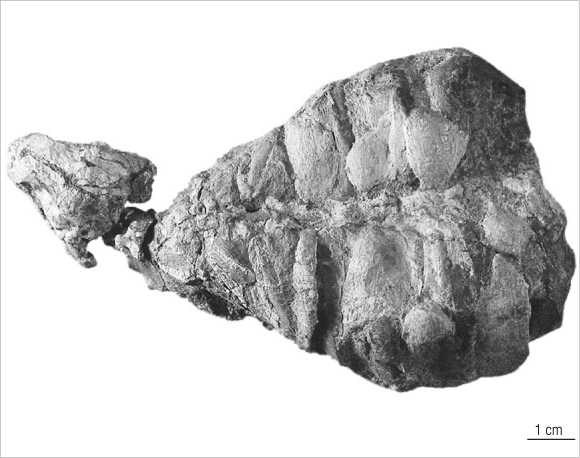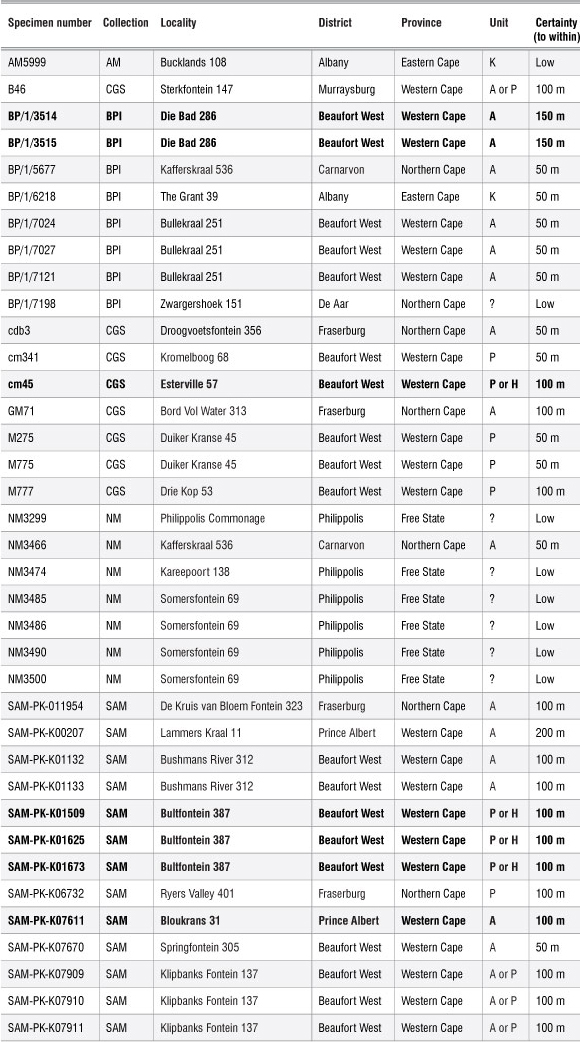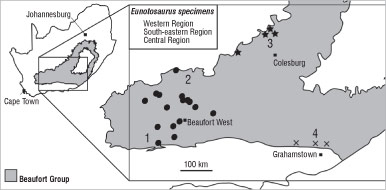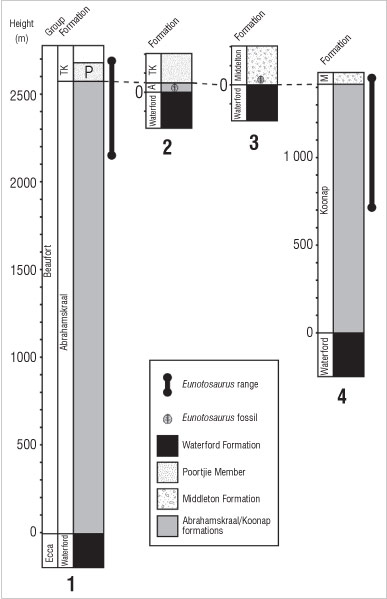Services on Demand
Article
Indicators
Related links
-
 Cited by Google
Cited by Google -
 Similars in Google
Similars in Google
Share
South African Journal of Science
On-line version ISSN 1996-7489
Print version ISSN 0038-2353
S. Afr. j. sci. vol.109 n.3-4 Pretoria Jan. 2013
RESEARCH LETTER
Biostratigraphic correlation in the Karoo: The case of the Middle Permian parareptile Eunotosaurus
Mike DayI; Bruce RubidgeI; John AlmondII; Sifelani JirahI
IBernard Price Institute of Palaeontology, University of the Witwatersrand, Johannesburg, South Africa
IINatura Viva, Cape Town, South Africa
ABSTRACT
The richness of fossil tetrapods from the Beaufort Group of South Africa has enabled biostratigraphic subdivision of this Permo-Triassic succession, with global applicability. Despite being the thickest of the seven biozones recognised, attempts at further subdivision of the Middle Permian Tapinocephalus Assemblage Zone (Abrahamskraal Formation) have not been successful, largely because the exact stratigraphic ranges of fossil taxa are unknown. This gap in knowledge has limited stratigraphic correlation of the Abrahamskraal Formation and hindered understanding of Middle Permian Karoo basin development. Currently, the lowermost Beaufort Group is split between an eastern and a western stratigraphic scheme and, because of poor outcrop and the relative paucity of fossils in the east, stratigraphic correlation between the two areas has been uncertain. Recent fossil discoveries of the parareptile Eunotosaurus africanus in the Eastern Cape and Free State provinces have extended its known geographic range in the east. An additional specimen from the lower Middleton Formation in the Eastern Cape has, for the first time, enabled the biostratigraphic correlation of this unit with the Poortjie Member of the Teekloof Formation in the west. These finds confirm the diachroneity of the boundary between the marine Ecca Group and the terrestrial Beaufort Group.
Keywords: Eunotosaurus; biostratigraphy; Permian; Karoo; parareptile; Beaufort Group
Introduction
The taxonomic affinity of the enigmatic Permian parareptile Eunotosaurus africanus, easily recognised in the field by its distinctive broad ribs (Figure 1), has long intrigued palaeontologists. The genus has been placed in the Parareptilia as the sole member of a sister taxon to the Millerettidae1,2 and, most recently, as a sister taxon to modern turtles.3 All specimens of Eunotosaurus come from the upper Tapinocephalus and Pristerognathus Assemblage Zones of the Permian Beaufort Group of South Africa4,5 and most specimens have been recovered from the western part of the Main Karoo Basin (Table 1, Figure 2) where the genus has already been used for biostratigraphic correlation.6

Source: Council for Geoscience, Pretoria
Figure 1: The Middle Permian parareptile Eunotosaurus africanus, specimen M777.
Table 1: List of Eunotosaurus specimens included in this study.

AM, Albany Museum, Grahamstown; CGS, Council for Geoscience, Pretoria; BPI, Bernard Price Institute (Palaeontology), Johannesburg; NM, National Museum, Bloemfontein; SAM, Iziko South African Museum, Cape Town.
A, Abrahamskraal Formation; P, Poortjie Member; H, Hoedemaker Member; K, Koonap Formation.
Specimens in bold are at the extremes of the range.

Figure 2: Eunotosaurus fossil localities in the Beaufort Group of South Africa, separated into regions. Numbers show the localities of the stratigraphic sections in Figure 3.
In this part of the basin the Tapinocephalus and Pristerognathus Assemblage Zones correspond approximately to the Abrahamskraal Formation and the overlying Poortjie Member of the Teekloof Formation, respectively.5 Correlation of these biozones with lithostratigraphic units in the east of the basin has been difficult as fossils are less abundant and the Tapinocephalus Assemblage Zone was only recently demonstrated to be present in there at all.7
Materials and methods
The Beaufort Group fossil tetrapod geographic information system (GIS) database8 was used to project the localities of all specimens of Eunotosaurus onto Google Earth satellite imagery (both use the WGS84 coordinate system) whence their stratigraphic position was deduced from geological maps.
The quality of locality information for each specimen varies, with many earlier discovered specimens being assignable only to the area of a farm. The range of strata that outcrops in the area of a locality, or across the farm as a whole, therefore has a direct influence on the accuracy with which each specimen could be placed stratigraphically (Table 1). Extensive fieldwork allowed refinement of the stratigraphic provenance of all specimens of Eunotosaurus whose stratigraphic position, as calculated from the geological maps, could potentially form one of the extremes of the stratigraphic range of the genus.
For the purposes of this study, because of the heterogeneous nature of the stratigraphy, the basin was divided into four regions: the northwestern, southwestern, central and southeastern Karoo (Figure 2). Stratigraphic sections were either measured by the authors or taken from the literature9-12 and drawn up for each region, after which each section was split into 50-m intervals. Such intervals represented the greatest provenance accuracy which could be determined for most of the fossils. The stratigraphic position of each Eunotosaurus specimen was then plotted on the stratigraphic section for its respective region, spread across the number of 50-m intervals each could possibly occupy. This approach compensated for the level of uncertainty accompanying all fossils, either because of the lack of precise locality data or because of the complexity of the geology or local topography. The range ultimately calculated is the minimum range for the genus based on the existing data with a maximum error of 50 m.
Institution abbreviations are as follows: SAM, Iziko South African Museum, Cape Town; BP, Bernard Price Institute (Palaeontology), Johannesburg; AM, Albany Museum, Grahamstown; NM, National Museum, Bloemfontein; CGS, Council for Geoscience, Pretoria.
Results
Compilation of all the locality data relating to Eunotosaurus indicates that the stratigraphically lowest specimens are SAM-PK-K07611 from Bloukrans 31, Prince Albert District, and BP/1/3514 and BP/1/3515 from Die Bad 286, Beaufort West District. Both localities are situated in the southwestern section of the basin. SAM-PK-K07611 occurs between 2150 m and 2200 m above the boundary between the marine Ecca Group and the terrestrial Beaufort Group as defined by Rubidge et al.13, while the latter two specimens are constrained to between 2200 m and 2350 m above this level. These localities are all within the upper Abrahamskraal Formation.
The stratigraphically highest specimens are CGS CM45, from Esterville 57 in the Beaufort West district, and SAM-PK-K1673, SAM-PK-K1625 and SAM-PK-K1509 from Bultfontein 387 in the Victoria West district - both localities are situated within the northwestern part of the basin. With reference to geological maps (map sheet: Republic of South Africa 3122, Victoria West, 1:250 000 Geological Series 1989), the locality data of CGS CM45 indicate that this specimen was collected from the lowermost Hoedemaker Member of the Teekloof Formation; however, as a result of the approximate determination of the coordinates, there is a slight chance that the specimen may have been found in the uppermost Poortjie Member. The SAM specimens are recorded as coming only from Bultfontein 387 - a farm which covers the upper Poortjie and lower Hoedemaker - so their actual position is not well constrained. Accordingly, CGS CM45 is the highest well-constrained occurrence and probably occurs in the lowermost part of the Hoedemaker Member. The stratigraphic range of Eunotosaurus in the west therefore extends from about 350 m below the top of the Abrahamskraal Formation to the lowermost Hoedemaker Member of the Teekloof Formation (Figure 3). This distribution gives it a total stratigraphic range of 450550 m, depending on local thicknesses, and corresponds to the upper Tapinocephalus and the entire Pristerognathus assemblage zones.5

A, Abrahamskraal Formation; M, Middleton Formation; TK, Teekloof Formation.
Section 1 = Western Region (south); section 2 = Western Region (north); section 3 = Central Region; section 4 = Southeastern Region.
Figure 3: The stratigraphic position of Eunotosaurus around the Karoo Basin. The localities of each section are shown in Figure 2.
In the Eastern Cape Province, two specimens are recorded from the Koonap Formation, in the Grahamstown district. Specimen AM5999 comes from the farm Schrikwaters Poort 109 and, although its locality is not recorded precisely, it is possible to constrain its range to the upper half of the Koonap Formation. On the farm The Grant 39, specimen BP/1/6218 occurs at 730 m above the Ecca-Beaufort boundary,12 also mid-Koonap Formation. A newly discovered specimen from the farm Wilton, 5 km west of Middleton Station in the Somerset East district (Eastern Cape Province), occurs in the lower Middleton Formation (Figure 4).

Figure 4: Eunotosaurus fossil impression embedded in sandstone on the farm Wilton, near Middleton, Eastern Cape Province (32°58'40.2"S, 25°45'58.5"E).
In the Free State, the specimens of Eunotosaurus are associated with scylacosaurid therocephalians and, as no dinocephalians have been discovered, these specimens are considered to fall within the Pristerognathus Assemblage Zone9; however, the lithostratigraphic context is uncertain here.9,11
The scarcity of fossil material in the eastern part of the Basin is problematic. The difference in stratigraphic regime, confounded by the absence of the Eodicynodon Assemblage Zone and an unknown proportion of the Tapinocephalus Assemblage Zone near Grahamstown,7 makes subdivision of the eastern formations uncertain. Although BP/1/6218 may prove to be the lowest occurrence of Eunotosaurus, until collecting efforts create a larger sample size, the stratigraphic ranges of specimens from the eastern Karoo Basin have limited use unless compared to the west.
Age
Traditionally, the age of the Tapinocephalus and Pristerognathus assemblage zones has relied upon comparisons to the Russian Permian, and more specifically to the Ischeevo fauna.5,14 This comparison places them in the Capitanian stage, dated at 265.8-260.4 million years ago.15 From existing material, the stratigraphic range of Eunotosaurus corresponds to the upper third of the Tapinocephalus Assemblage Zone and the entirety of the Pristerognathus Assemblage Zone. The upper end of the Eunotosaurus range is therefore dated to about 260 million years ago, at the Capitanian-Wuchiapingian boundary.14 The lower extent of its range is more difficult to determine, but given the data available from biostratigraphic correlation with Russia, the first appearance of the genus would probably fall within the middle Capitanian.
Conclusion
Our study demonstrates that Eunotosaurus has a restricted stratigraphic range of about 450 m within the fluvial lower Beaufort Group of the Main Karoo Basin and can therefore be useful for biostratigraphic correlation. The presence of this genus in only the upper part of the Koonap Formation and lowermost Middleton Formation supports the lithostratigraphic correlation of the Poortjie Member in the western Karoo Basin to the base of the Middleton Formation in the East.16 As the distribution of Eunotosaurus corresponds to a fixed time period, the recognition that the genus occurs in the upper but not the lower Tapinocephalus Assemblage Zone in the south has further utility; the presence of Eunotosaurus with a Tapinocephalus Assemblage Zone fauna on the Ecca-Beaufort boundary in the Carnarvon district, Northern Cape,6 and its presence with a Pristerognathus Assemblage Zone fauna immediately above the Ecca-Beaufort boundary at Philippolis, southern Free State,9 confirm the younging of the Karoo palaeoshoreline towards the north.
Acknowledgements
We thank the Palaeontological Scientific Trust (PAST), the NRF and the Department of Science and Technology for the generous funding making this research possible. We also acknowledge two anonymous reviewers for their useful and helpful comments on the manuscript.
Authors' contributions
M.D. wrote the manuscript, calculated specimen stratigraphic positions and was involved in the fieldwork; B.R. was the project leader and assisted in writing the manuscript; J.A. conducted some of the fieldwork; S.J. was involved in fieldwork and assisted in stratigraphic interpretation.
References
1. Laurin M, Reisz RR. A reevaluation of early amniote phylogeny. Zool J Linn Soc. 1995;113(2):165-223. http://dx.doi.org/10.1111/j.1096-3642.1995.tb00932.x [ Links ]
2. Tsuji LA, Müller J. Assembling the history of the Parareptilia: Phylogeny, diversification, and a new definition of the clade. Foss Rec. 2009;12(1):71 -81. http://dx.doi.org/10.1002/mmng.200800011 [ Links ]
3. Lyson TR, Bever GS, Bhullar B-AS, Joyce WG, Gauthier JA. Transitional fossils and the origin of turtles. Biol Lett. 2010;6(6):830-833. http://dx.doi.org/10.1098/rsbl.2010.0371, PMid:20534602, PMCid:3001370 [ Links ]
4. Keyser AW, Smith RHM. Vertebrate biozonation of the Beaufort Group with special reference to the Western Karoo Basin. Ann Geol Sur S Afr. 1979;12:1-36.
5. Rubidge BS, editor. Biostratigraphy of the Beaufort Group (Karoo Supergroup). S Afr Comm Strat Biostrat Ser. 1995;1:1-46.
6. Rubidge BS, Modesto SP Sidor CP. Eunotosaurus africanus from the Ecca-Beaufort contact in Northern Cape Province, South Africa - implications for Karoo Basin development. S Afr J Sci. 1999;95(11/12):553-555.
7. Modesto SP Rubidge BS, De Klerk WJ, Welman J. A dinocephalian therapsid fauna on the Ecca-Beaufort contact in Eastern Cape Province, South Africa. S Afr J Sci. 2001;97:161-163.
8. Nicolas M. Tetrapod biodiversity through the Permo-Triassic Beaufort Group (Karoo Supergroup) of South Africa [dissertation]. Johannesburg: University of the Witwatersrand; 2007.
9. Welman J, Loock JC, Rubidge BS. New evidence for diachroneity of the Ecca-Beaufort contact (Karoo Supergroup, South Africa). S Afr J Sci. 2001;97(7/8):320-322.
10. Jirah S. Sedimentological, palaeontological & stratigraphic analysis of the Abrahamskraal Formation (Beaufort Group) in an area south of Merweville, South Africa [dissertation]. Johannesburg: University of the Witwatersrand; 2009. [ Links ]
11. Cole DI, Wipplinger PE. Sedimentology and molybdenum potential of the Beaufort Group in the main Karoo basin, South Africa. C for Geosci Mem. 2001;80:1-225. [ Links ]
12. Mason R. A bio- and litho-stratigraphic study of the Ecca-Beaufort contact in the southeastern Karoo Basin (Albany district, Eastern Cape Province) [dissertation]. Johannesburg: University of the Witwatersrand; 2007. [ Links ]
13. Rubidge BS, Hancox PJ, Catuneanu O. Sequence analysis of the Ecca Beaufort contact in the southern Karoo of South Africa. S Afr J Geol. 2000;103(1):81-96.
14. Rubidge BS, Erwin DH, Ramezani J, Bowring SA, De Klerk WJ. High-precision temporal calibration of Late Permian vertebrate biostratigraphy: U-Pb zircon constraints from the Karoo Supergroup, South Africa. Geology. In press 2013, doi:10.1130/G33622.1. http://dx.doi.org/10.2113/103.1.81 [ Links ]
15. Wardlaw BR, Davydov V Gradstein FM. The Permian period. In: Gradstein FM, Ogg JG, Smith AG, editors. A geologic time scale 2004. Cambridge: Cambridge University Press; 2004. p. 249-270. [ Links ]
16. Hill RS. Explanation to geological map sheet 3224 Graaff-Reinet. Pretoria: Geol Sur S Afr; 1993. p. 1-31. [ Links ]
 Correspondence:
Correspondence:
Mike Day
BPI Palaeontology, Palaeosciences Centre, School of Geosciences, University of the Witwatersrand
Private Bag 3, Johannesburg 2050, South Africa
Email: michael.day@students.wits.ac.za
Received: 11 June 2012
Revised: 02 Oct. 2012
Accepted: 08 Oct. 2012
© 2013. The Authors. Published under a Creative Commons Attribution Licence.














